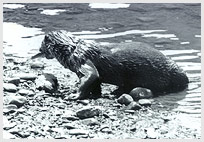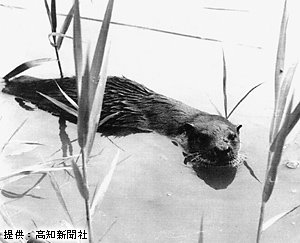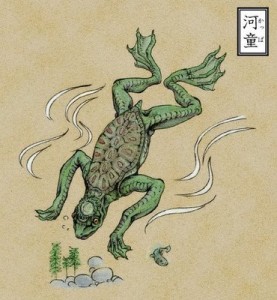Japanese River Otter Extinction?
Posted by: mystery_man on September 9th, 2012
Recently we had some sad animal news in Japan when the Japanese river otter (Lutra nippon), also known as Lutra lutra whiteleyi and the 日本獺 or 日本川獺, nihonkawauso or nipponkawauso in Japanese, was declared extinct by the Japanese Ministry of the Environment on August 28, 2012. The announcement comes after several decades of searches for any possible remaining specimens.

Some background on the Japanese river otter.
The Japanese river otter was a nocturnal predator, endemic to Japan, which reached 26 to 30 inches long at maturity. Inhabiting mostly midstream and downstream regions, it was once found abundantly throughout Japan.
The number of Japanese river otters decreased rapidly beginning around the Maiji and Taisho eras due to hunting for its fur and liver (which was used as a medication for tuberculosis) and further continued with habitat destruction, water contamination, large scale river construction, and even attacks by domestic dogs. Although the otters were designated as a Special Natural Treasure in 1965, the steady rate of decline continued.

A preserved museum specimen.
The only known captive specimen was purportedly kept at a zoo in Ehime prefecture from 1956 to 1969. It is widely believed to have been one of the last of its kind. The last known officially verified sighting of a Japanese river otter was in 1979.
Despite the lack of any confirmed sightings past 1979, the otter was listed as critically endangered and thought to only be present in the Southern area of Shikoku island, a fraction of its former range. Official searches had been commissioned by both prefectural governments and non- governmental organizations in recent years in order to find any remaining specimens and hopefully salvage the species if it was still out there. The search was unsuccessful in locating any remaining otters. This brings us to the present, August 29, 2012, when the Ministry of the Environment finally concluded that the Japanese river otter no longer exists.

A preserved specimen seen at the Aichi Expo on March 4, 2005.
Not everyone is as pessimistic as the Ministry of the Environment. Yoshihiko Machida, a professor emeritus at Kochi University told the Japanese newspaper, The Mainichi, that he remained hopeful that the Japanese river otter still survives. “There was a case of otter droppings being confirmed in 1999. I think it is possible that they still exist, and I want to continue my investigations,” he said.
I tend to agree that the extinction announcement may possibly be premature. It is first of all important to remember that a species being officially declared extinct is not necessarily the final word. History is full of examples of species being found to exist long after their supposed extinction dates, in some cases very, very long after (Coelacanth anyone?). The process of going extinct is typically a gradual process, with populations or scattered individuals often hanging on in remote habitats, and it is difficult to gage at what point we can say with certainty that a species is gone from the face of the Earth. Usually, the decision to list a species as extinct stems largely from a lack of verified sightings or physical evidence of the animals over many years.

In the case of the Japanese river otter, although the last confirmed sighting is set at 1979, the fact is that there are still many unconfirmed or unverified sightings that continue to this day, some of them in areas of their former range where they have long been considered gone. Some of these unverified sightings may perhaps be misidentifications. The exotic pet trade in Japan is a booming business and there have been several cases of muskrats and even a nutria being found in the wild here. It could be that the otter sightings were of something like this, however I do not feel comfortable dismissing all sightings as such. It seems to me worthwhile to pursue these persisting sighting reports of otters that still may remain.
In addition to sightings reports, there were droppings of an otter found in 1999. This is significant because the otters had a very specific diet of shrimp and other aquatic organisms, and the type of scat can be readily identified as being that of an otter. Since it can be demonstrated that the droppings were in fact those of an otter, the droppings found in 1999 indicate the presence of at least one individual well past the last known sighting. 1999 to 2012 is not a large amount of time when talking about the gradual extinction of a species, so the droppings, in conjunction with continuing sightings reports, give us more reason to think that some of these animals may persist in the wild.

Another factor to consider is that contrary to the image it has of bustling metropolises, Japan has many remote river habitats where a small population of otters could remain undetected. The searches carried out by national and prefectural governments do not seem to have been particularly aggressive or all encompassing. Most of these searches were focused on the areas the otters were last known to inhabit, namely on Shikoku island, rather than an all inclusive search of the entirety of the otter’s former domain. The problem with this is that even if the otters have indeed disappeared from their last known habitat, they may have remained in far flung areas of their historical distribution. This is further supported by sightings of the creatures in areas of the otter’s range outside of Shikoku. The remoteness of some of the terrain and size of the Japanese otter’s former range suggest to me that some of the animals may have evaded detection throughout these searches, particularly in harder to reach habitats.
To me, a complete absence of sightings and no physical evidence whatsoever would be more indicative of a conclusive extinction, but this is not the case with the Japanese river otters. Considering the continuing sightings, the discovery of droppings, and existence of suitable, remote habitat within a large former range, I feel that we should not necessarily close the door on this species just yet. I would add, however, that if it still exists, the population of these animals is likely very small. It may well be the case that there are not enough individuals to maintain a stable breeding population, which would therefore make the species more or less functionally extinct.

Interestingly, the Japanese River Otter is connected to cryptozoology in more ways than one. It is thought by some in cryptozoological circles here in Japan to be an explanation behind the sightings of another (an – otter?) Japanese cryptid, the legendary Kappa, which is a sort of bipedal, frog-like creature thought to inhabit Japanese rivers. In addition, the otter has been proposed as a possible explanation for the Matsudodon, a mewling, aquatic cat-like cryptid that was often spotted frolicking in the Edo river near Matsudo-shi (where I live now, interestingly enough) in the 1970s.

A kappa
In addition to the Japanese river otter, the horseshoe bat of Okinawa, a bird species, an insect species, and a shellfish species were also declared extinct in the recent announcement. The Japanese subspecies of black bear was also declared extinct on the island of Kyushu, where it has not been seen since 1957, although it should be noted that the subspecies is not extinct in other areas of Japan.
About mystery_man









its always sad to hear a species went extinct
There are probably still a handful out there, living undetected, but we will probably never find them.
Not a good topic on which to greet you back to the board, but welcome back.
This piece illustrates well both the reasons for and the pitfalls attending extinction declarations. This animal was known to exist, and has gone a long time without a verifiable sighting. But much in this game depends upon the intensity of the search and the confidence that all known potential habitat was properly canvassed.
There seems to be good reason to hold out hope in this instance. I knew that white-tailed deer populations in my area were at, maybe beyond, saturation when I actually started seeing them regularly. (When one comes upon a totally intact, freshly dead carcass in the woods, one REALLY knows there are probably too many.) By the same token, an animal’s numbers can fall below the threshhold at which they are readily detectable, while remnant populations continue their lives out of general sight, the impression of extinction helped along by the scientific inattention that follows an extinction declaration.
Once again, it always pays to make careful pronouncements and to keep an open mind. (Not to mention noting that commercial interests may have much to gain from extinction declarations.)
Good piece.
Would be interesting to see from the standpoint of genetics just how distinct this species of otter was from the general population of river otters which are widely dispersed throughout the circumpolar boreal regions of the hemisphere and considering how well connected Japan was to Eurasia in the not so distant past, geologically speaking. I agree that given their elusive natures and Japan’s topography, despite its dense human population, that small groups could be hangin’ on. Given the distinctive odor that river otters have (I know having had a family nesting beneath my cabin along a river once) one would think that a dog could be employed to hunt out the droppings better than humans depending on actual sightings.